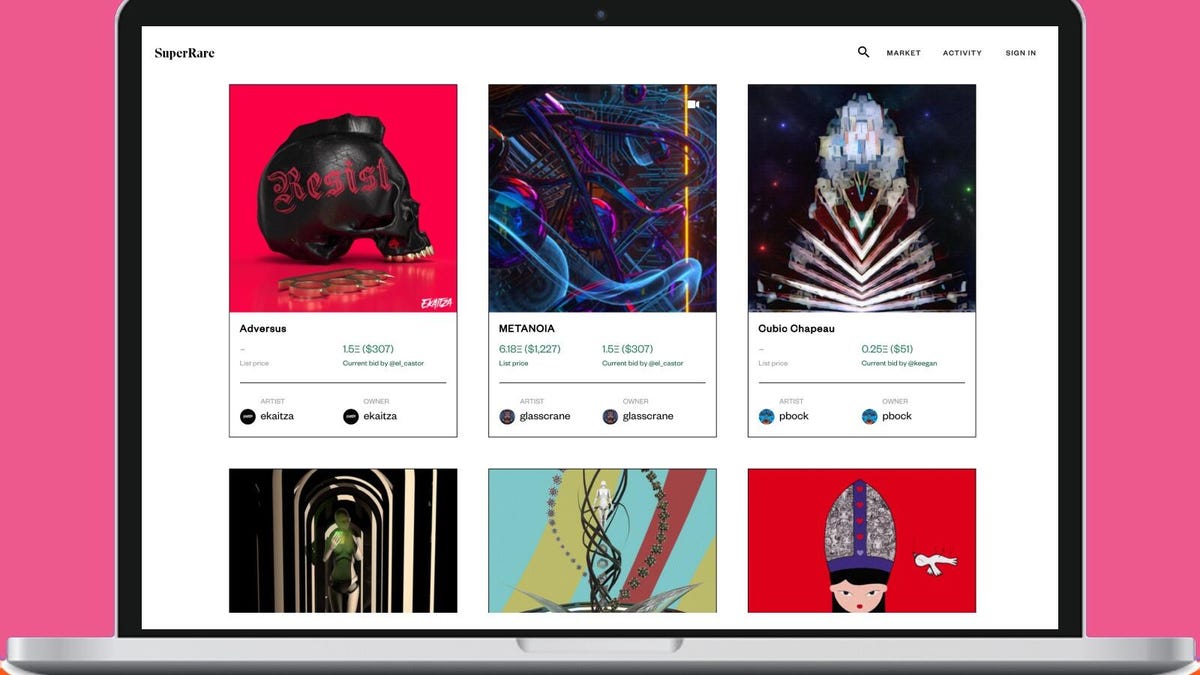Collect digital art on this platform to display in your home, or in VR
Artists have earned more than $1.6 million on SuperRare, a blockchain-based platform for collecting one-of-a-kind digital art.

Search for original digital art on the SuperRare platform, and pay in Ethereum cryptocurrency.
As the coronavirus pandemic shuttered access to museums and galleries around the globe, some artists and collectors are turning to a new medium: digital art.
SuperRare, an online platform for buying and selling digital art, saw an explosion in activity since quarantines went into effect in March. At the start of 2020, it had sold $345,000 worth of art in its marketplace. As of late August, that number had reached more than $2 million. About $1.6 million of earnings to date have gone directly to artists, according to cofounder and chief product officer Jonathan Perkins.
Read more: Best laptops, desktops and tablets for designers and creatives in 2020
The platform is "Instagram meets Christie's," the famous art auction house, Perkins said. "Each artwork is minted as a one-of-a-kind digital asset by an artist in the network, enabling it to be bought, sold and traded by collectors on the open market."
Digital art found on SuperRare functions the same way an original work would in an auction house -- it can only be owned by one person at a time.
SuperRare uses Ethereum blockchain for minting these digital objects, as well as the cryptocurrency for paying for them. Blockchain technology allows each work to be tracked and traded transparently and securely, making it easy to verify authenticity, and create a record of everyone who has owned it previously -- something rare to find in the art world.
And, since each artwork file in itself is simply a jpeg, gif, MP4 or 3D digital model, its scarcity and value is confirmed by the blockchain, Perkins said. Because each token lives on Ethereum and not just in the SuperRare database, if something were to happen to the platform, all artwork would still exist as it does today.
Some people display their digital art in a digital frame in their home, or in a virtual reality space.
So how do you display digital art? Collectors are still experimenting, Perkins said, but many use digital frames like those from Meural or Canvia. Others project it on a tablet or a flatscreen TV. And an increasing number of people are showing off their new purchases in open, ownership-based VR worlds such as Decentraland and Cryptovoxels. Almost every active artist and collector on SuperRare is also a resident in one of these virtual worlds, Perkins added -- it may be niche, but there seems to be an interconnected virtual economy growing in these online spaces.
Read more: All the best apps for drawing on your iPad
Digital art has a number of benefits, Perkins said. It can be viewed and shared by billions of people globally at once. You can bring your art collection anywhere in the world without having to pack it up. The market is available 24/7. And each work that lives on the blockchain has that authenticity stamp baked in.
The platform is also giving artists a way to generate income during a difficult economic time, especially as traditional galleries, shows and art fairs have either shut down or scrambled to move online. As of late August, 8,350 pieces of art had been purchased by more than 830 people on SuperRare. While in traditional galleries, artists often take home about 50% of each sale, on SuperRare, they take home 85% from each primary sale, and 10% of each secondary sale as a royalty.
The digital art space is still very new, and can be rather technical to understand, Perkins said. "But this is the beginning of a paradigm shift," he added. "[We're] disrupting and digitizing a $60 billion-plus a year industry that hasn't yet been brought into the 21st century."

